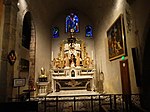Fréjus Cathedral
The Saint-Léonce Cathedral is located in the historic center of the southern French city of Fréjus in the Var department . It has been classified as a Monument historique since 1862 . The medieval cathedral district includes the Romanesque church with the adjoining pre-Romanesque (Merovingian) baptistery , the provost house and the cloister .
The church was originally the seat of the Bishop of Fréjus . In 1957 the dioceses of Fréjus and Toulon were united. The bishopric of the new diocese of Frejus-Toulon is now Toulon; Saint-Léonce has the rank of co- cathedral .
Location of the buildings
The cathedral building is located on the southeast side of the complex, to the west is the narthex and the baptistery. With the nave, there is a cohesive unit with a common south wall. To the north of the baptistery is the provost's house with the cloister to the east.
cathedral
tower
The towering tower rises above the vestibule, which was built in its current form in the 18th century, but also includes older components. It is square in the lower area, followed by an octagonal attachment with the sound openings for the bells. A pointed tent roof with yellow and green shingles closes the tower at the top.
Narthexportal
The south portal originally dates from the first half of the 16th century. The lintel has been preserved from the time it was built . It is dated April 1, 1530 and was created by Jacobus Durandi. The Flamboyant Gothic style framework is a replica.
Inside of the cathedral
The interior of the church consists of the connected naves of two churches: Saint-Étienne in the north from the 11th and 12th centuries was the parish church of Fréjus. Notre Dame in the south was the episcopal church . It was initially built on the south wall of Saint-Étienne, later the ships were opened to each other. The vaulting of both churches and the pillars are made of one piece and date from the end of the 12th to the beginning of the 13th century. The unprofiled, unadorned ribbed vault develops a monumental effect.
A similar arrangement of two churches under one roof can also be found in Aix and Apt .
Furnishing
- A wooden crucifix dates from the 16th century.
- Two statues depict the bishops Barthélémy (1599–1637) and Pierre (1637–1654). They date from the 17th century.
- A painting by the Roman painter Camillo Salurno from 1561 shows the Holy Family .
- The panel painting “ Ascension ” from 1551 is in the choir .
- The wooden choir stalls were commissioned by Bishop Juvenal in 1441 and redesigned in the 18th century.
- In the nave of Saint-Étienne there is a wood-carved, gilded retable by Jacobus Durandi from the 15th century. The five-axis polyptych is dedicated to St. Margaret, who can be seen in the center of the work of art, above her a crucifixion scene. The large figures to the left of the saint are Antonius and Maria Magdalena , above them smaller representations of a group of Annunciation . On the right, Michael and Katharina are shown in large, above Raphael and John the Baptist . Left at the edge from bottom to top: Lorenz, a bishop and Peter of Luxembourg . Right at the edge from bottom to top: Stephen , a bishop and a depiction of the third of himself .
organ
The history of the organs in the cathedral goes back to the year 1600. In 1810 a new organ was inaugurated, which was built by the organ builder Borme-Gazel. In the years 1855–1857 a choir organ was commissioned, which was built by Aristide Cavaillé-Coll. The current instrument was built in the years 1962–1967 by the organ builder Gonzales, using material from the previous instrument. The organ was reorganized from 1986 to 1991. It has 35 registers on three manuals and a pedal . The actions are mechanical.
|
|
|
|
|||||||||||||||||||||||||||||||||||||||||||||||||||||||||||||||||||||||||||||||
Baptistery
The baptistery is an early Christian building from the 5th century, an example of Merovingian art with oriental influences. It is square on the outside in the basement, the upper floor and the interior floor plan are polygonal. A flat conical roof covers the building.
The interior of the basement is designed as an octagon. Wall niches with semicircular cones form an arcade rotunda . The arcade arches are supported by eight monolithic columns, six of which are spoils from older buildings. In the middle of the rotunda is the baptismal font . In the tambour bullet, the shape changes to a sixteenth corner . Eight niches of equal size are arranged between eight window arcades .
Cloister
The cloister belongs to the Capitou, the wing of the cathedral capitals . The capitou and cloister were built after the cathedral was completed in the 13th century. The two-story corridor surrounds a rectangular courtyard. Its arcades are slightly pointed and rest on double columns made of white marble . The Corinthian capitals show the key, the symbol of the bishop and the stylized lily , symbol of Charles I of Anjou. A coffered ceiling made of pine wood dates from the 14th century and is richly painted according to Catalan tradition.
literature
- Rolf Legler : Cote d'Azur. France's Mediterranean coast from Marseille to Menton (= DuMont documents. Dumont art travel guide. ). 8th edition. DuMont, Cologne 1990, ISBN 3-7701-1152-4 .
Individual evidence
Web links
Coordinates: 43 ° 25 ′ 59.5 ″ N , 6 ° 44 ′ 13 ″ E











